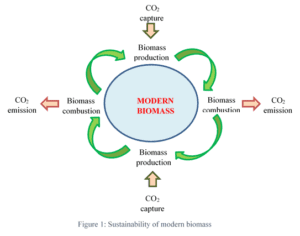Biomass Meaning, Ecology, Environment and Energy Explained
Biomass is organic matter which is produced through biological processes and can be broken down through biological processes.
The term; “biomass” is one which has become fairly common, especially in the contexts of renewable energy technology and sustainable development, among others.
This article provides an elaborate description of biomass from the following perspectives;
-Biomass, Ecology, and the Ecosystem
-A Look at Ecological Processes
-Biomass and Sustainable Development
What is Biomass?
Biomass generally refers to all forms of organic matter on Earth [6]. It can also be described as matter that is derived from living organisms (which may be living or dead).
A distinctive characteristic of biomass is the fact that it is renewable. Since it occurs in nature, such materials are continuously produced and available. Based on this understanding, we may describe biomass as renewable organic material that is produced by plants and animals.
When defining biomass, we should expect to find words like organic, renewable, sustainable, green, energy, ecology and ecosystem, among others. These terms all bear relation to the processes that produce biomass, and the nature of biomass itself.
Biomass, Ecology, and the Ecosystem
The field of ecology deals with the ecosystem; which itself is a combination of biotic (living) and abiotic (non-living) components and factors.
From this perspective, there are different ways by which the term can be defined.
One of these is on the basis of species population. Species biomass refers to a measure of the total number, quantity, or magnitude of organisms of a particular species in a given ecosystem.
Population biomass, similarly, refers to a measure of the overall magnitude of organisms (or organic material) within a given population.
However, from a general ecological perspective, biomass is the sum total (in terns of mass) of organic material (from both living and non-living sources) which is present in an ecosystem.
This would include plant matter and animal matter of all forms. By implication, therefore, biomass refers to all forms of biological material, from biological sources.
Plants and animals are the primary sources. Examples of biomass would therefore include wood, leaves, animal waste, plant waste, remains of both plants and animals, and microbial matter. The common characteristic of these materials, lies in their biological source. Therefore, biomass is simply biological-mass, or biologically-derived material.
A Look at Ecological Processes
With respect to ecology, there are natural processes by which biological matter is circulated through the ecosystem in a continuous manner. These are the processes that either produce, utilize, or destroy biomass in nature. Some of them are hereby discussed briefly;
1). Photosynthesis
Photosynthesis is the primary process by which biomass is produced. It involves the transformation of sunlight (solar energy), water and carbon dioxide into chemical energy, where the end-products include carbohydrates (usually in the form of glucose). It is mostly carried out by organisms which possess the green pigment chlorophyll, such as some bacteria, green algae, and green plants [3].
Because carbohydrates are themselves organic materials, produced from organic processes, photosynthesis is the basic means through which biomass is created by nature in an ecosystem.
Photosynthesis provides an avenue for chlorophyll-pigmented organisms to grow and increase in mass, and these organisms in turn serve as food (directly or indirectly) to other organisms in the ecosystem, thereby leading to the growth (increase in biomass) of these organisms. Since all living organisms depend on food for survival, photosynthesis may be seen as the main process which supports the survival of organisms on Earth.
2). Fertilization and Reproduction
In both plants and animals, fertilization and reproduction are the processes that lead to increase in organic population. The rate of reproduction (sexual or asexual) in any ecosystem is directly proportional the rate of increase in organic matter.
This is because of the obvious fact that living organisms increase in number as they reproduce. Reproduction does not always lead to an increase in biomass, but it usually prevents a significant loss of biomass due to other processes like decomposition and combustion.
3). Feeding
Feeding is basically a process which uses and transforms biomass.
The biological matter produced by photosynthesis is consumed and utilized in the process of feeding. However, this biomass is not lost as it is transformed into energy and nutrients (thereby reversing the initial process of photosynthesis) which are used for growth, survival and reproduction.
4). Decomposition/Putrefaction
Through decomposition biomass is momentarily lost to the environment.
The word “momentarily” is used here because decomposition converts biomass into chemical matter and greenhouse gases like sulfuric oxide, nitrous oxide, water vapor and carbon dioxide, and most of these materials can be recycled for photosynthesis and growth, thereby creating biomass.
5). Combustion
Combustion is quite similar to decomposition, in that it involves the break-down and ‘destruction’ of biomass to produce chemical and gaseous materials.
During combustion, biomass is used and consumed to release energy, often in the form of heat, which can then be utilized for any of various purposes.
Biomass and Biochemistry
Since it is biologically-derived, and composed of chemical matter, biomass can be defined from a biochemical perspective, as an aggregate of organic matter whose dominant chemical component is carbon.
Aside carbon, biomass also contains nitrogen, hydrogen, sulfur and oxygen, usually alongside smaller amounts of other elements like heavy metals and alkali earth metals. The average proportion (%) of the main chemical constituents of biomass is as follows [8];
| Element | Proportion (%) |
| Carbon | 45.0 |
| Oxygen | 42.0 |
| Hydrogen | 6.0 |
| Ash | 5.2 |
| Chlorine | 1.4 |
| Sulfur | 0.2 |
| Nitrogen | 0.2 |
Generally, biomass is composed of bio-polymers (complex organic compounds) that include hemicellulose, lignin, cellulose. ash, and volatiles.
Biomass and the Environment
Biomass is an essential part of our natural environment.
What this implies, is that it is both produced and consumed naturally by, and in, the environment.
The break-down of biomass, either by combustion or decomposition, releases gases and other breakdown products that may be potentially harmful to the environment. In the same vein, organisms naturally utilize most of these potentially harmful products for their growth, development and survival.
A classic example is the use of carbon dioxide as part of the requirements for photosynthesis by green plants and other chlorophyll-pigmented organisms. This shows that in general, biomass is conserved in the environment, since it is continuously produced and consumed in a natural cycle.

As we have pointed out, biomass does not (on the overall) have any negative of significant impacts on the environment. However, there are a number of immediate effects which biomass (and its usage) has on the environment, most of which are not quite positive. Some of these are briefly discussed as follows;
1). Pollutant-Emission
When biomass breaks down either through combustion or decomposition, it usually releases various pollutants into the environment.
These pollutants include particulate matter, sulfuric oxides, nitrogen oxides, and volatile organic compounds [9]. As a result of the release of these pollutants, living organisms are often exposed to the risk of illness and other negative effects of environmental pollution.
2). Deforestation
In many regions, biological matter occurs in the form of vast amounts of forest vegetation.
Given the present rate of industrialization, population growth and urbanization in the world, these forest areas are subject to encroachment and disintegration.
The causes of deforestation in the world today include environmental pollution, expansion of inhabited land by the human population, and the search for alternative forms of energy.
Ultimately, deforestation is not good for the environment [10]. This is because vegetation (trees and smaller plants) acts as carbon sinks, which absorb atmospheric carbon dioxide and effectively utilize it to produce carbohydrate by the process of photosynthesis. In the absence of sufficient vegetation on Earth, the rate and severity of global warming are bound to increase.
3). Potential Depletion of Natural Resources
Water is the most common natural resource which is consumed in large quantities by biomass. This is obvious when we consider the large volumes of water required for irrigation in agricultural projects.
In order to grow and preserve biomass, the environment must give up significant amounts of its resources. Under the condition that these resources are not completely renewed after they have been consumed, the environment is likely to decline with time.
This problem is the main reason behind environmental conservation and sustainable development efforts, which are all aimed at preventing environmental degradation.
Biomass and Energy
With regards to the relationship between biomass and energy, two terms are of importance; biofuel and bioenergy.
‘Biofuel’ is simply another way to describe biomass, especially when it is being used as a source of energy. Biological matter can serve as a fuel because of the chemical energy which us essentially stored in it [1].
When biomass is broken down through combustion, this energy is released.
Bioenergy, is another term which, predictably, describes the energy that is released when biological matter is broken down. In other words; bioenergy is simply energy derived from organic matter.
There are different means by which bioenergy can be harnessed. However, biofuel may occur in any of three main forms;
1. As a solid (Fire wood)
2. As a liquid (Biodiesel and Ethanol)
3. As a gas (Biogas)
A brief highlight is given for each of these possible forms, as follows;
Biomass and Bioenergy: Solid Biofuel
The most common solid form of biofuel is firewood.
It is fairly simple to understand how firewood can be used to generate bioenergy. Since biomass contains chemical energy (which was basically produced by the process of photosynthesis) this energy is released from biomass when it is broken down by combustion.
In many parts of the world (especially developing regions) it is not uncommon to use solid biofuel as a source of energy. In such regions, timber and other woody materials from plant organisms are burnt to produce heat which is used mainly for domestic purposes.
A more enhanced example of the use of solid biomass as fuel can be seen in waste-to-energy plants. Here, solid waste (which usually contains a high proportion of organic matter) is burnt under controlled conditions, producing heat energy of up to 1,800°F [7].
The use of solid biomass to generate bioenergy is often accompanied by significant environmental concerns. These concerns involve the release of potentially harmful materials like carbon dioxide, ash, sulfuric oxide, nitrous oxide, and carbon monoxide into the environment, thereby increasing the prospects of climate change and environment pollution.
For these reasons, solid biofuels are not widely used or encouraged as a source of energy. In enhanced facilities like waste-to-energy plants, there are usually provisions made to minimize pollution by absorbing or converting pollutants.
Such provisions include the use of scrubbers to treat gaseous emissions, and the collection of ash and lead residues which may be used for manufacturing purposes (ceramics, textiles, bricks, fertilizer).
Biomass and Bioenergy: Liquid Biofuel
Biomass can be utilized in its liquid form, to produce energy.
The most common liquid forms of biofuel are biodiesel and ethanol.
Biodiesel is a term used to refer to fatty acid methyl-esters (FAME) which are a group of chemicals produced from the reaction between lipids (like vegetable oils and fat) and alcohol, otherwise known as transesterification.
Unlike petroleum-derived fuel, biodiesel has the advantage of being derived from renewable sources. It is also a more sustainable option and does not release as much pollutants (especially greenhouse gases) into the environment, as petroleum-derived fuel. Biodiesel has a relatively low carbon footprint and is biodegradable, giving it less potential environmental impact.
Ethanol is itself a common organic compound. It is a member of the alcohol group of chemicals, having the chemic formula; C2H5OH [5]. Physically, ethanol occurs as a colorless, flammable, low-density, low-melting point liquid. Compared to gasoline, it has a low energy-density, and therefore is required to be burnt in large volume, in order to produce considerable amount of energy.
Compared to biodiesel, ethanol can be viewed as a less-efficient and cost-effective energy option. This is because biodiesel yields approximately 93% more energy than is required to produce it, whereas ethanol yields only about 25% more energy than that which is expended while producing it [2].
Both biodiesel and ethanol have found significant application in the transport sector, among other sectors where they are used as alternatives to petroleum products.
However, some of the limitations faced in the effort to develop these biomass energy sources include the volatility of liquid biofuels, and the debate over the relative importance of agricultural land use and the use of land to grow crops like sugar cane for the sole purpose of liquid biofuel production.
Asides these challenges, there is the issue of environmental impact. The use of liquid biofuel is associated with the release of gaseous pollutants into the atmosphere, alongside other contaminants.
Biomass and Bioenergy: Gaseous Biofuel
When it occurs in gaseous form, biofuel is simply referred to as biogas.
Biogas is itself simply a mixture of gases which are produced when biomass is broken down by microorganisms under anaerobic (no-oxygen) conditions [4]. It comprises mostly of methane (40%-74%) which occurs alongside carbon dioxide and trace amounts of other gases.
Physically, biogas is a colorless, odorless and flammable gas, which is slightly denser than methane. It has a lower energy density than other biofuels like ethane and biodiesel, however, it is categorized as renewable, environment-friendly (relatively) and economical.
Biomass and Sustainable Development
Sustainable development is aimed at achieving sustainability in three main areas; environment, economy and society.
So far, this article has pointed out that bioenergy is a relatively clean and environment-friendly form of energy, at least in comparison to fossil fuels like coal and petroleum.
Biomass is also economically sustainable. This is because it is derived from renewable sources and can be continuously produced without much expenditure. Much of biomass is recycled and generated naturally, with the main source of replenishment being renewable solar energy that is used in photosynthesis.
Materials which are used for generating energy include several which are not very difficult to obtain, like wood pellets and sawdust.
The societal acceptance of biological matter usage especially for energy production, is limited by a few factors such as the environmental considerations, growth of other more appealing alternatives like solar and wind, and the issue of land-use (for growing plants to be used as biofuel sources).
Conclusion
Biomass is a commensurate term used to describe all forms of organic, biologically-derived matter.
While there are numerous possible definitions of biomass, one of its unique characteristics lies in the fact that it is renewable. In an ecological sense, biomass is a measure of all organic matter in a species population, or an entire ecosystem. Natural processes like photosynthesis, feeding and decomposition are responsible for the cycling (creation, utilization, consumption/destruction) of biomass.
The chemical composition of biomass includes elements like nitrogen, carbon, hydrogen and oxygen. Biomass can be used to generate energy (bioenergy), in which case it will be referred to, collectively, as biofuel. Biofuel may be used in solid, liquid or gaseous form.
Firewood is the most common form of solid biomass, which can undergo combustion to produce energy. It is directly derived from plant organisms, and its use is limited due to adverse environmental consequences.
The liquid forms of biomass with respect to energy-generation include biodiesel and ethanol. These fuels are both organic and renewable.
Gaseous biofuel is called biogas. It is produced when biomass is subjected to decomposition under oxygen-deficient conditions, and it is composed of methane, carbon dioxide, and small amounts of other gases.
In comparison to fossil fuels, biomass energy does not pose extremely severe risks to the environment. It is therefore relatively sustainable, and provides an economic leverage because it is derived from renewable sources. However, biomass is not a widely-accepted and well-developed renewable energy material, mostly due to the existence of other more appealing alternatives.
References
1). Carstens, A. (2021). “Photosynthesis Converts Solar Energy Into Chemical Energy.” Available at: https://asknature.org/strategy/how-plants-transform-sunlight-into-food/. (Accessed 26 January 2022).
2). Center for Sustainable Systems, University of Michigan (2021) “Biofuels Factsheet.” Pub. No. CSS08-09. Available at: https://css.umich.edu/sites/default/files/Biofuels_CSS08-09_e2021_0.pdf. (Accessed 26 January 2022).
3). Dobrijevic, D. (2021). “What is photosynthesis?” Available at: https://www.livescience.com/51720-photosynthesis.html. (Accessed 26 January 2022).
4). EPA (2021). “Basic Information about Anaerobic Digestion (AD).” Available at: https://www.epa.gov/anaerobic-digestion/basic-information-about-anaerobic-digestion-ad. (Accessed 27 January 2022).
5). Helmenstine, A. M. (2020). “Ethanol Molecular Formula and Empirical Formula.” Available at: https://www.thoughtco.com/ethanol-molecular-and-empirical-formula-608476. (Accessed 26 January 2022).
6). Houghton, A.; Hall, F.; Goetz, S. J. (2009). “Importance of biomass in the global carbon cycle.” Journ. Geoph. Res.: Bio. Vol. 114, Available at: https://doi.org/10.1029/2009JG000935. (Accessed 26 January 2022).
7). Kitto, J. B., Jr, and Hiner, L. A. (February 1, 2017). “Clean Power from Burning Trash.” ASME. Mechanical Engineering.; 139(02): 32–37. Available at: https://doi.org/10.1115/1.2017-Feb-1. (Accessed 26 January 2022).
8). Parmar, K. (2017). Biomass- An Overview on Composition Characteristics and Properties. IRA-International Journal of Applied Sciences (ISSN 2455-4499), 7(1), 42-51. Available at: http://dx.doi.org/10.21013/jas.v7.n1.p4. (Accessed 26 January 2022).
9). PFPI (2011). “Air pollution from biomass energy.” Available at: https://www.pfpi.net/air-pollution-2. (Accessed 26 January 2022).
10). Schwartz, J. (2014). “6 Reasons Stopping Deforestation (Still) Matters.” Available at: https://www.greenpeace.org/usa/6-reasons-stopping-deforestation-still-matters/. (Accessed 26 January 2022).

